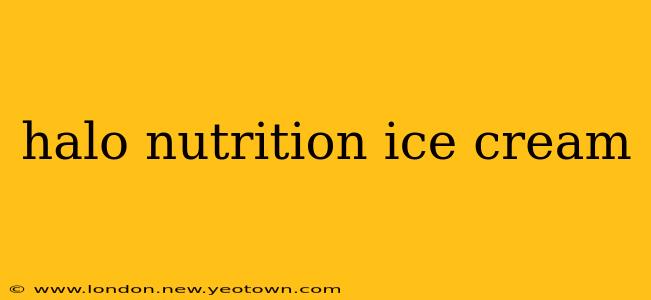Let's be honest, ice cream is a universally loved treat. But for those watching their waistlines or seeking healthier alternatives, indulging can feel like a battle between desire and diet. Enter Halo Top, the ice cream that promised guilt-free indulgence. But how does it stack up nutritionally? Is it truly as healthy as advertised? Let's explore the nutritional profile of Halo Top and answer some common questions.
What are the Nutritional Facts of Halo Top Ice Cream?
The beauty (and sometimes the beast) of Halo Top lies in its nutritional information. It boasts significantly fewer calories and less fat than traditional ice cream brands. A typical pint of Halo Top contains around 240-360 calories, depending on the flavor, compared to the 800-1200 calories you'll find in a similar-sized container of premium ice cream. The reduced calorie count is largely achieved through the use of less fat and sugar, often employing sugar alcohols like erythritol.
However, it's crucial to remember that "low-calorie" doesn't equate to "health food." While calorie count is important, we need a broader look at the macronutrient profile. Halo Top typically offers a decent amount of protein, contributing to feelings of satiety, which can be beneficial for weight management. However, the sugar alcohol content can lead to digestive issues for some individuals, so moderation is key.
How Does Halo Top Compare to Other Ice Cream Brands?
Comparing Halo Top to traditional ice cream brands highlights its significant calorie and fat reduction. Premium brands are packed with cream, butterfat, and sugar, leading to a higher caloric density. Halo Top, using alternative ingredients and processes, significantly lowers these figures. However, it's not a direct "one-to-one" comparison. The taste and texture differ considerably, often described as "lighter" and sometimes "icier" than traditional ice cream.
Is Halo Top Ice Cream Healthy?
The "healthiness" of Halo Top is subjective and depends heavily on individual dietary needs and goals. While it's lower in calories and fat than many alternatives, it's not a health food in the strictest sense. The use of artificial sweeteners and stabilizers needs consideration. Moderation is crucial, even with Halo Top. It should be a treat, not a staple in a healthy diet.
What are the Ingredients in Halo Top Ice Cream?
Halo Top's ingredient list varies by flavor but generally includes a blend of milk, cream, protein isolate (often whey), erythritol, and other sweeteners, along with natural and artificial flavorings and stabilizers. The specific ingredients and their proportions influence the nutritional profile and overall taste of each flavor. Checking the nutrition label for each specific flavor is essential for informed consumption.
Does Halo Top Ice Cream Have Sugar Alcohols?
Yes, many Halo Top flavors contain sugar alcohols, primarily erythritol. Sugar alcohols provide sweetness with fewer calories than sugar, but they can have a laxative effect if consumed in large quantities. While generally considered safe, individuals sensitive to sugar alcohols might experience digestive discomfort after consuming Halo Top.
Is Halo Top Ice Cream Good for Weight Loss?
Halo Top can be a helpful tool for weight management when incorporated into a balanced calorie-controlled diet. The lower calorie count allows for a treat without significantly impacting overall calorie intake. However, it's not a magic bullet. Sustainable weight loss relies on a holistic approach incorporating regular exercise and a balanced diet, not just swapping one ice cream for another.
In conclusion, Halo Top offers a lower-calorie and lower-fat alternative to traditional ice cream, making it a viable option for those seeking a healthier treat. However, mindful consumption and awareness of its ingredients are crucial. It's a tool, not a solution, in a broader healthy lifestyle. Remember always to consult with a healthcare professional or registered dietitian for personalized dietary advice.

